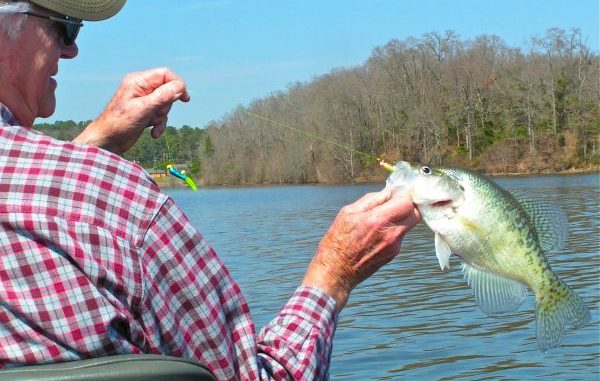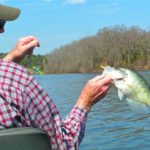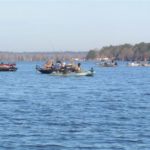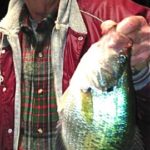
Bob Mitcham is more than a crappie enthusiast — he’s a crappie fanatic. And Lake D’Arbonne is where he goes to enjoy his addiction. Here’s how he mops up.
The first time I met Bob Mitcham, he had so much fishing equipment it took a 25-foot step-in cargo van to haul it all around.
I mean, he was into fishing hook, line and sinker.
Of course, in those days some 30 years ago, it was his business. He ran a route around Northeast Louisiana, supplying virtually every convenience store and bait shop with all kinds of, well, hooks, lines and sinkers, and poles and fish baits, etc.
Those were the days before super outdoor stores and fishing catalogs.
Hook, Line & Sinker was the name of his business.
After spending time at Mitcham’s house, camp and in his boat, I must say that he might have more fishing tackle today than he even had then. But now it is simply for pleasure.
And most of it is directed toward chasing crappie during the cold months of the year on Lake D’Arbonne.
When things get right, the fish go crazy. But they’re not alone: So do the people.
It’s a standing joke around the lake this time of year that when the fish are biting you can almost walk boat to boat near the main bridges across the lake at Highway 2 and Highway 33.
Finding a spot to fish — and even before that, a place in line to launch your boat — is kind of like a day at your local Division of Motor Vehicles office looking for a new driver’s license.
Hurry up. And wait.
OK, my apologies to the DMV folks, but you know what I mean.
“It is a bit crazy out there in February and March, but when the shad get bunched up and the fish start following them and feeding, there are an unbelievable number of fish caught,” Mitcham said. “I don’t like fishing right next to somebody, and I’ll usually try to move away from the crowd as best I can, but it’s worth it.”
Mitcham is an excellent fisherman who, like most of us, cut his eye teeth chasing largemouth bass, both for fun and in competitive tournaments. Now, he specializes in catching white perch on jig poles in deep water.
On a recent trip, we were in 30 to 35 feet of water fishing 20 to 25 feet deep. Some other folks were also catching fish suspended at shallower depths, 10 to 15 feet deep, but also in deep water.
Welcome to cold weather crappie fishing on “the Bone.”
On that day, we landed about 40 good keeper fish in about four hours, and we more than half of them weighed well over a pound.
What’s Mitcham’s secret?
“You have to find the fish and then stay on top of them,” he said. “You have to make sure and fish at the right depth. Be patient.
“You can fish a little above them and they’ll come up for the bait, but if you fish below them they won’t go down to it. That’s just the way it is.”
He has everything in his crappie arsenal for a reason. But no piece of equipment is more important than a good fishing graph.
“Without a depth finder, you are just pretty much guessing,” Mitcham said. “You can watch other people and fish in the same vicinity, but you’ll be depending on luck.”
And he doesn’t depend on luck: He keeps his eye on the depth finder or graph almost all the time while he’s fishing, but he never misses that slight hook set from the guy in the back of the boat, turning to see if there is a fish on or not.
He has an uncanny knack for seeing wads of shad and crappie on the electronics and saying “We’re on the fish. We should catch one here” just a few seconds before we catch one
This time of year, he lives for the “tap.”
“I love to fish, and always have,” Bob said, glancing around as I counted upwards of 120 boats within sight of where we are fishing. “They wouldn’t be here if they weren’t catching fish. Or at least seeing somebody else catching them.”
Mitcham, a Bernice native who now lives in Monroe and has a camp on the lake, is very familiar with D’Arbonne. He laughs when he tells about putting the boat in at a small landing on the north end of the lake in the early days and not going very far but almost getting lost in the thick, flooded timber.
Today, there is little timber or any way to get lost. And you can see from one end of the lake to the other.
And, at nearly 75 years old, Mitcham is as comfortable navigating the lake in his Ranger Commanche with a 200-horsepower outboard as he is finding the fish and making sure you catch fish for supper.
Bob said finding equipment and lures that you feel confident in and comfortable with is part of the battle.
Also, it’s important to learn more than one technique. While he usually jig fishes with plastics, he will also use hair jigs when the fish get finicky in the spring and start to move shallow.
Another good technique in the rush to land D’Arbonne crappie is using a small Road Runner spinner.
When the fish are in 20 feet of water, Mitcham pitches it out, counts it down to 20 and begins a slow retrieve. It often produces some of the bigger fish.
He also said to check your jig or small spinner regularly to make sure the bait is sitting level instead of with the tail dropping down. Mitcham ties a small clip to his line and then attaches the bait, ensuring it is level all the time.
And he always uses a crappie bite trailer. It doesn’t matter what color it is, “as long as it is chartreuse,” he added.
Mitcham doesn’t like spider rigging, but he said it will work on the lake.
But his favorite way to fish is with one pole in each hand. He usually holds the jig as still as possible, and sometimes he rigs two jigs of different colors about a foot apart.
He doesn’t lay the pole down because sometimes the hit is so slight you’ll miss the fish if you don’t feel it and set the hook quickly. In fact, sometimes the larger fish will hit a jig coming up and actually leave slack in your line.
You might not even feel the strike.
So always keep your eye on the line for that. If your line goes slack in 35 feet of water, you’ve either got a fish or your jig just learned how to swim.
Top areas of the lake this year are usually crowded with boats.
The top four areas are near the Bernice Bridge on Highway 2 near Lester’s Marina, the Ruston Bridge on Highway 33 near Jake’s, the old State Park area north of Highway 33 and the wide-open spaces in front of the spillway on the south end of the lake.
The last chapter in Mitcham’s Bible of Crappie Fishing involves another fish.
“Never let a yellow bass in your boat” because it will mess you all up, he said.
There are lots of those little critters in the same areas as crappie this time of year, and Mitcham doesn’t like them stealing his crappie bites or keeping him from landing his favorite fish — crappie.



